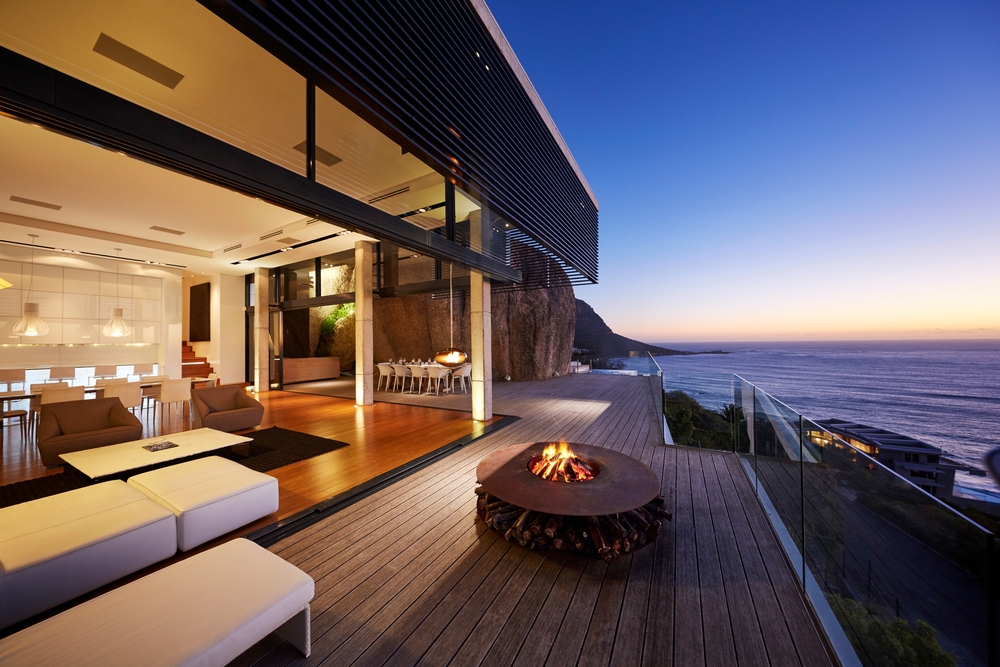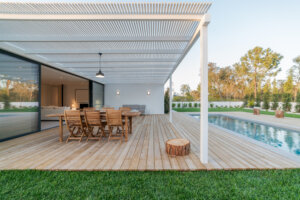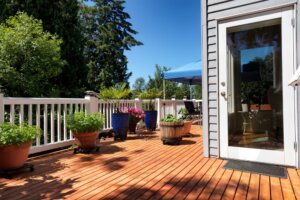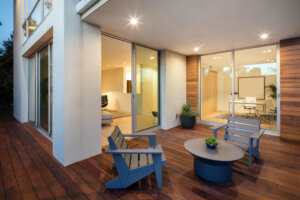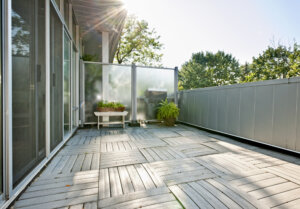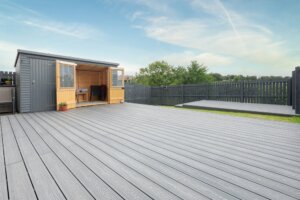As we all know, Canadian winters can be cold, dark, and above all else, long. That being said, we Canadians have definitely learned to make the most of our four months of summer, for the most part by spending as much time as possible outside. One of the best ways to enjoy the outdoors is by hanging out in your own backyard on a beautiful brand new deck. Canada’s intense climate means you have to be somewhat more selective about what kind of deck you choose to have installed. The good news is that between materials and with a regular deck maintenance schedule, you’ll have no shortage of options. More good news – we’re here to help you decide by outlining the pros and cons of popular decking materials and the prices associated with deck builds across Canada.
1. Pressure Treated Lumber
Pressure Treated Lumber is wood that has been treated in order to maximize its durability. Pressure treatment protects wood from moisture and U.V. damage, wards off insects, and reduces the odds of fungal decay, making this a great option for Canadian backyards. The best part about this option is the price point. PTL is widely considered the most economical of possible deck materials. It will cost between $15 and $25 per square foot to have a PTL deck installed, depending on whether you’d like to add any extra features, like stairs or railings.
The downside, however, is that these decks aren’t particularly long-lasting and require a fair bit of maintenance, especially when compared to their synthetic counterparts. Though the material has undergone the pressure treatment process, they are still susceptible to water damage. Most retailers recommend that in addition to applying a water repellant on a yearly basis, you also re-sand, re-stain and reseal every 2-5 years. When this maintenance schedule is properly followed, these decks can last up to 20 years. If this sounds manageable, consult with a deck specialist or a carpenter about a design for your yard.
2. Redwood and Cedar
If you’re looking for an all-natural wood option, we recommend going with a redwood or cedar deck. These woods contain oils that naturally protect them from moisture and insects. As a result, these decks can remain chemical free and still hold up in harsh conditions. That being said, they are not entirely maintenance free. In addition to being power washed annually, these decks should be treated with a wood preservative and a stain to maintain their colour.
These decks are typically more aesthetically pleasing than those made from pressure treated wood, but they are also slightly more expensive – costing between $20 and $30 per square foot. There is a range of natural hardwood options, so consult with a pro to determine the best look for your yard.
3. Exotic Hardwood
Exotic hardwoods are the most expensive of the natural options, costing around $30 per square foot. Though beautiful, these hardwoods are dense and hard to work with. That being said, if you’re looking for something truly special for your backyard, this might be the best option for you. You’ll need to get in touch with a specialist for most of these materials, so start researching today to find the right pro for the job.
4. Composites
Many deck specialists consider composite decks to be the best option for homeowners. Composite materials are made from a mix of recycled wood and reclaimed low-density plastic. Low-density plastic means that it doesn’t retain heat so it won’t get warped in the sun. Composite decks not only last longer than natural materials, but they also require far less maintenance. That being said, because they are made partially of wood, they can sustain damage from moisture.
Although this material is slightly more expensive, around $35 per square foot, you won’t have to worry about its longevity and you won’t have to pay for much maintenance. As an added bonus, it comes in an array of colours. For more information, connect with a pro to review your composite decking options.
5. Poly Vinyl Chloride (PVC)
Unlike composite decks, PVC decks are completely inorganic, making them virtually maintenance free. They aren’t susceptible to water or insect damage, they hold their colour, are easy to clean, and difficult to scratch. That being said, plastics typically don’t fare well in harsh climates. In the summer, the surface of these decks will heat up, and when exposed to extreme cold, PVC will become brittle and crack. Pricing depends on whether you’re looking for solid or hollow slats – however, high-end solid materials would likely be on par with the cost of a composite deck.
6. Aluminum
Your final option is aluminum. Aluminum requires less maintenance than any of the other options and is also lighter, stronger and longer lasting. Longer planks and lighter materials mean installation time is usually less than other models. These decks also typically carry a lifetime warranty.
The drawback of these decks is the fact that they are expensive. A pro would likely charge $15 per linear foot for material, plus the cost of design, framing, and labour. That being said, what you spend on the material you’ll save on maintenance fees down the line. Based on the state of your home, your budget, and other factors, a pro will help you determine whether the upfront cost is worth it in the long run.
Below are the average costs of Decks & Patio services across different cities in Canada:
| City | Average | Minimum | Maximum |
| Calgary | $11,533 | $100 | $50,000 |
| Edmonton | $12,474 | $1,000 | $50,000 |
| Hamilton | $13,836 | $2,500 | $45,000 |
| Oshawa | $11,450 | $500 | $50,000 |
| Ottawa | $7,965 | $350 | $28,000 |
| Toronto | $13,565 | $135 | $50,000 |
| Vancouver | $6,456 | $300 | $30,000 |
*Costs based on 1264 verified Canadian homeowner reviews as of March 2022
In a few short months, it’ll be summer once again, meaning it’s time to get your deck project started with the help of a HomeStars pro. We’ve got 5 reasons why you should leave the deck building to the pros. After all, what better way to enjoy the longer days and warmer nights than on a beautiful new deck in the comfort of your own backyard?
Article Update June 14, 2022.
